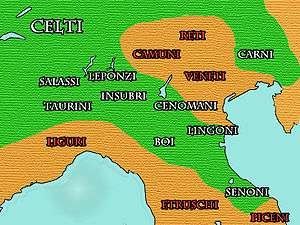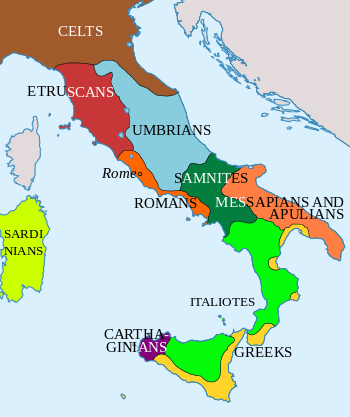Insubres

The Insubres or Insubri were a Gaulish population settled in Insubria, in what is now the Italian region of Lombardy. They were the founders of Mediolanum (Milan). Though completely Gaulish at the time of Roman conquest, they were the result of the fusion of pre-existing Ligurian and Celtic population with Gaulish tribes who had come from what is now Central Europe.
Classical sources
The Insubres are mentioned by Cicero, Polybius, Livy, Pliny the Elder, Strabo and Caecilius Statius.
Ethnicity of the Insubres
Polybius called the Insubres the most important Celtic tribe of the Italian peninsula, while according to the Livy they were the first to inhabit Cisalpine Gaul, from the VII century BC.
Insubres were part of the Golasecca culture, which takes its name from a town near Varese, where Abbot Giovanni Battista Giani made the first findings of about fifty Celtic graves with pottery and metal objects. It is a culture that developed at the end of the Late Bronze Age, between the rivers Po, Serio and Sesia, and which has its counterpart in the Central European Hallstatt culture.
Culture and society
The Insubres culture followed then what was a slow and of its own evolution. Thanks to the cultural and commercial exchanges with neighboring areas, such as Etruria, Venetia and Transalpine Gaul, the Insubres knew progress and created a distinct society of their own. In the light of archaeological findings it can be also assumed that it was an oligarchic society, where power was in the hands of a few Lords.
History
The History of the Insubres, like that of other Gauls and of Italic peoples, was written by ancient Roman and Greek writers. Apart from Livy's section on the Gallic Invasion of northern Italy, their writings came in the context of their covering Roman history and concentrated on battles between the Romans and the Insubres and other Gallic tribes in northern Italy
In 225 BC the Insubres and the Boii, their Gallic neighours to the south of the River Po, decided to rebel against Rome. This was prompted by developments which started in 283 BC, when unspecified Celts besieged Arretium (Arezzo in Tuscany) and defeated a Roman force which came to the aid of the city. The Romans sent envoys to negotiate the release of Roman prisoners, but the envoys were killed. A Roman army was sent to the ager gallicus (the name the Romans gave to an area on the Adratic coast which had been conquered by the Senone Gauls), routed a Senone force, occupied their territory, killed most of the Senones and drove the rest out of their land. Afraid that the same fate might occur to them, the neighbouring Boii joined the Etruscans in a rebellion, but their combined force was defeated at the Battle of Lake Vadimo in the same year.[1]
What prompted the Insubers to join the Boii in another rebellion was a law passed in Rome which provided for the subdivision of the ager gallicus into Roman administrative units. This created fears among the Boii and Insubres that the Romans were now fighting wars to exterminate and expel the enemy and annex their territory [2]
In 225 BC, the Boii and Insubres paid large sums of money to Gaesatae mercenaries led by Aneroëstes and Concolitanus. The Gaesatae were Gauls from Gallia Transalpina (the Roman name for what is now southern France). A force of up to 70,000 men ravaged Etruria. The Gauls and troops of Roman allies met near Clusium (Chiusi). The Gauls did not engage them and withdrew to Feasulae (Fiesole) at night. They then defeated the Romans at the Battle of Faesulae (225 BC). However, they were routed by the combined forces of the two Roman consuls, Lucius Aemilius Papus and Gaius Atilius Regulus, at the Battle of Telamon.[3]
After the Battle of Telamon, the Romans attacked and defeated the Boii and forced them to submit to Rome.[4] In 224 BC the Romans attacked Insubre territory. In 223 BC the Insubres sued for peace, but the Romans turned this down and attacked them. The Romans were now determined to be in control of Gallia Cisalpina (the Roman name for the area where the Gallic tribes of northern Italy lived). In 222 BC the Romans besieged Acerrae, an Insubre fortification on the right bank of the River Adda between Cremona and Laus Pompeia (Lodi Vecchio). The Insubres could not relieve Acerrae because the Romans controlled all the strategic points around it. Therefore, they hired 30,000 Gaesatae mercenaries and, led by Viridomarus (or Britomartus), they besieged Clastidium, and important and strategically well placed town of the Marici (a Ligurian people who were Roman allies), hoping that this would force the Romans to lift their siege. Instead, the Romans split their forces. The consul Marcus Claudius Marcellus headed for Clastidium and his colleague Gnaeus Cornelius Scipio Calvus continued the siege of Acerrae. At the Battle of Clastidium Marcus Claudius defeated the Gallic forces and killed Viridomarus in a single battle. Meanwhile, Gnaeus Cornelius took Acerrae. With the fortress taken and the Insubre king dead, the Romans then easily took the capital of the Insubres, which they named Mediolanum (Milan). The Insubres surrendered and were forced to become Roman allies. The Romans founded garrisoned colonies at Cremona and Placentia (Piacenza). The former was on the north bank of the River Po and the latter was close to its south bank (in Insubre and Boii territory respectively). This was done to secure the crossing of the river and the gateway to Liguria. They also established a garrison at Mutina (Modena) which was to become a colony in 182 BC.[5][6]
In 218 BC the Insubres and the Boii rebelled in anticipation of Hannibal's invasion of Italy in the Second Punic War (218-201 BC). They attacked Cremona and Placentia, forcing the settlers to flee to Mutina, which was besieged. The praetor Lucius Manlius Vulso set off from Ariminum with 20,000 infantry and 1,600 cavalry. He was ambushed twice on the way. He relieved the siege of Mutina, but was in turn besieged nearby. The consul Publius Cornelius Scipio was sent to support him with fresh troops. Meanwhile, Hannibal reached Italy. He defeated Publius Scipius at the Battle of Ticinum, in Insubre territory [7][8] and the other consul, Tiberius Sempronius Longus, at the Battle of the Trebia, near Placentia.[9][10] Hannibal wintered near Placentia and then moved on to central and southern Italy. We next hear of the Gauls during the Second Punic War in relation to the Battle of the Metaurus (207 BC). Hannibal's brother, Hasdrubal Barca, was bringing reinforcements from Spain for his brother who was in southern Italy. He passed through northern Italy and recruited Gallic soldiers. Hasbrubal's forces, including his Gauls were routed at this battle in central Italy.[11][12] At this point, Hannibal's campaign in Italy came to a dead end.
After several other clashes, the Insubres made an alliance with Rome in 194 BC, maintaining some autonomy. In 89 BC they obtained Latin citizenship and, in 49 BC, Roman citizenship. The Romanisation of the Insubres was probably quick owing to the presence of Roman colonies and to Julius Caesar using Mediolanum as a staging post for his conquest of Gaul (58–50 BC). Caecilius Statius (c. 220 BC – c. 166 BC), a Roman comic poet was born in Insubria, possibly in Mediolanum. He was originally a slave and was probably a war captive who was taken to Rome. Caeciulus was the name of his patron, probably a member of the powerful Metelli clan. His work was greatly acclaimed.
References
- ↑ Polybius, The Histories, 2.19-20
- ↑ Polybius, The Histories, 2.21.-9
- ↑ Polybius, The Histories, 2.22-27
- ↑ Polybius, The Histories, 2.31.7
- ↑ Polybius, The Histories, 2.32-35
- ↑ Berresfrord Ellis, Celt and Roman, pp. 163-66
- ↑ Livy, The history of Rome, 21.46
- ↑ Polybius, The Histories, 3.65
- ↑ Livy, The History of Rome, 21.53-55
- ↑ Polybius, The histories, 3.71-74
- ↑ Livy, The History of Rome, 27.48-49
- ↑ Polybius, The Histories, 11.1-3
Bibliography
- Ardovino A.G., (2001)Archeologi e storici sulla Lombardia preromana, tra equivoci e prospettive, dall’etnogenesi alla Wölkerwanderung al diffusionismo, in La protostoria in Lombardia, (Atti del 3° Convegno Archeologico Regionale Como 1999), Como, pp. 77–96.
- ARSLAN E. A., (2004) Dai Golasecchiani agli Insubri, in Celti dal cuore dell’Europa all’Insubria, Celti d’Insubria. Guerrieri del territorio di Varese, Catalogo della mostra (Varese, 28.11.2004-25.4.2005), pp. 18–25.
- Berresford Ellis, Peter,(1998) Celt and Roman, The Celts in Italy, New York, St Martin's Press, ISBN 978-0094758209
- De Marinis, Raffaele, (1991). "I Celti Golasecchiani". In Multiple Authors, I Celti, Bompiani.
- De Marinis, Raffaele, (1990) Liguri e Celto-Liguri, Officine grafiche Garzanti Milano, Garzanti-Scheiwiller
- Giangiulio, M., (1999)Storiografie, ideologie, metodologie. Ancora sul transitus Gallorum in Italiam in Livio (V,34-35) e nella tradizione letteraria, in Rassegna Studi del Civico Museo Archeologico di Milano 63-64, pp. 21–34.
- GRASSI, M. T., (1995) La romanizzazione degli Insubri. Celti e Romani in Transpadana attraverso la documentazione storica e archeologica, Milano.
- GRASSI, M. T., (1999) I Celti della Cisalpina Centrale: dall’ager Insubrium alla XI Regio Transpadana, in Insubri e Cenomani tra Sesia e Adige, Seminario di Studi (Milano 27-28.2.1998), “Rassegna di Studi del Civico Museo Archeologico e del Civico Gabinetto Numismatico di Milano”, LXIII-LXIV, pp. 101–108.
- Lyvy, (2004) The War with Hannibal: The History of Rome from its Foundation Books 21-30: The History of Rome from Its Foundation Bks. 21-30, London, Penguin Classics, ISBN 978-0140441451
Polybius, (2010) The Histories(Oxford World's Classics), Oxford, Oxford University Press, ISBN 978-0199534708
- Tibiletti, Bruno, M. G., (1978) "Ligure, leponzio e gallico". In Popoli e civiltà dell'Italia antica vi, Lingue e dialetti, ed. Prosdocimi, A. L.,129–208. Rome: Biblioteca di Storia Patria.
- Tibiletti Bruno, M. G., (1981) "Le iscrizioni celtiche d'Italia". In I Celti d'Italia, ed. E. Campanile, 157–207. Pisa: Giardini.
- Whatmough, J., (1933) The Prae-Italic Dialects of Italy, vol. 2, "The Raetic, Lepontic, Gallic, East-Italic, Messapic and Sicel Inscriptions", Cambridge, Massachusetts, Harvard University Press
